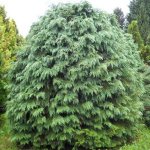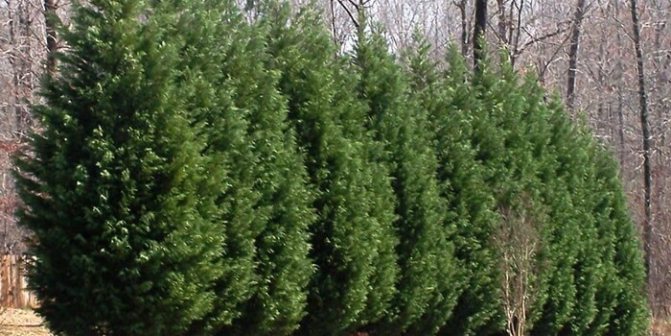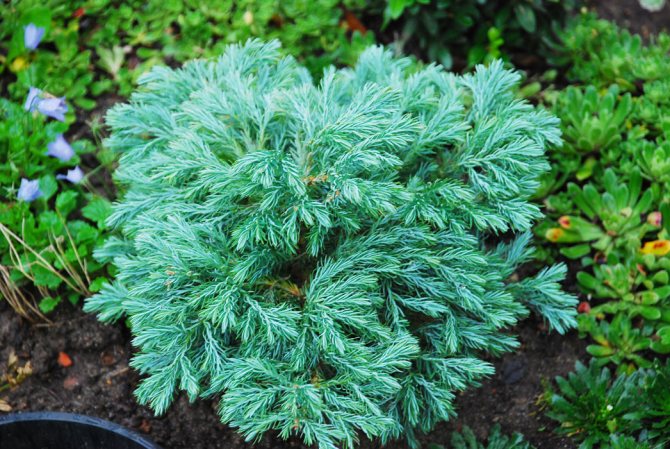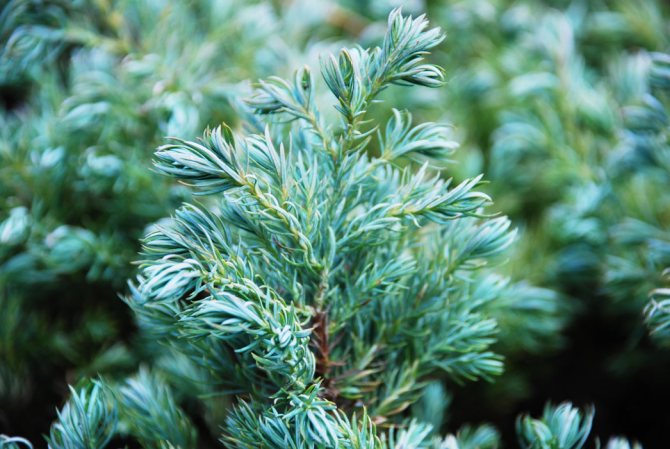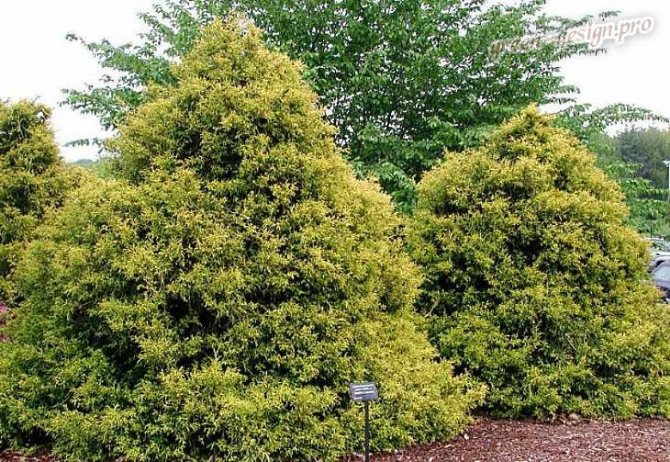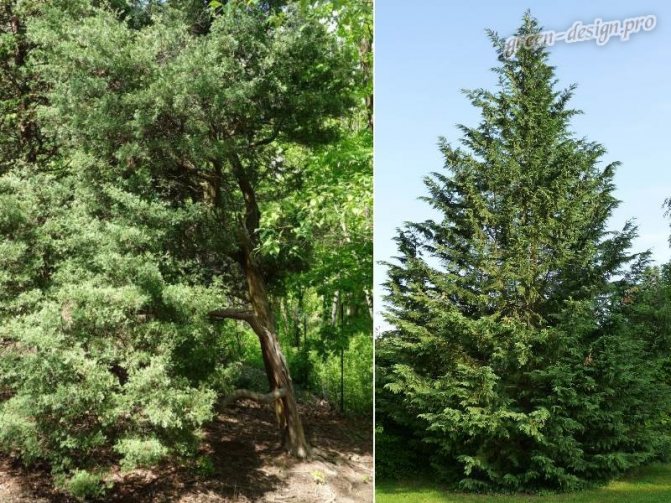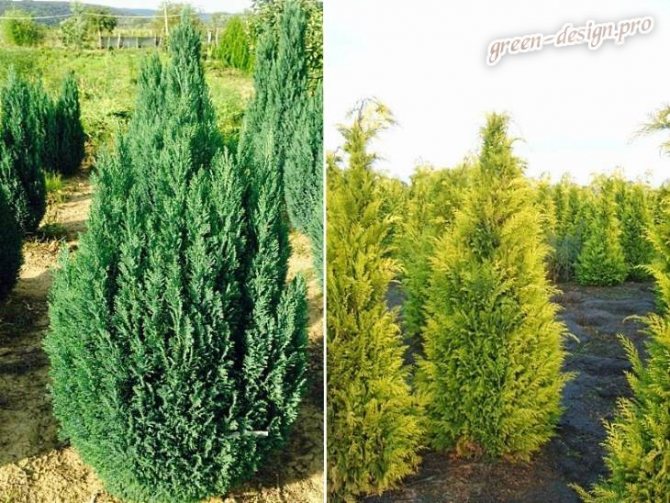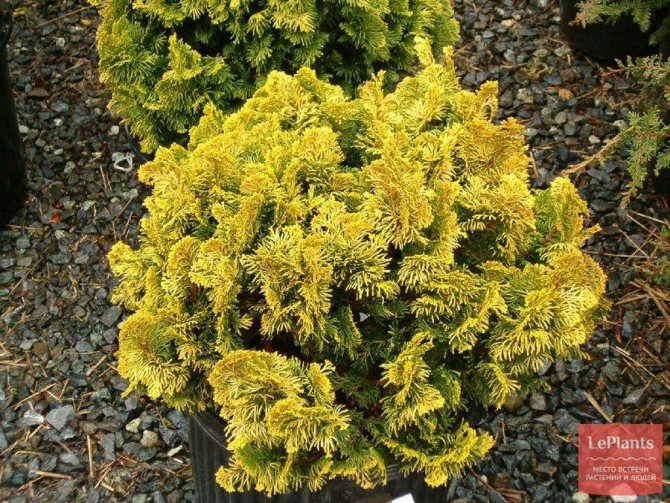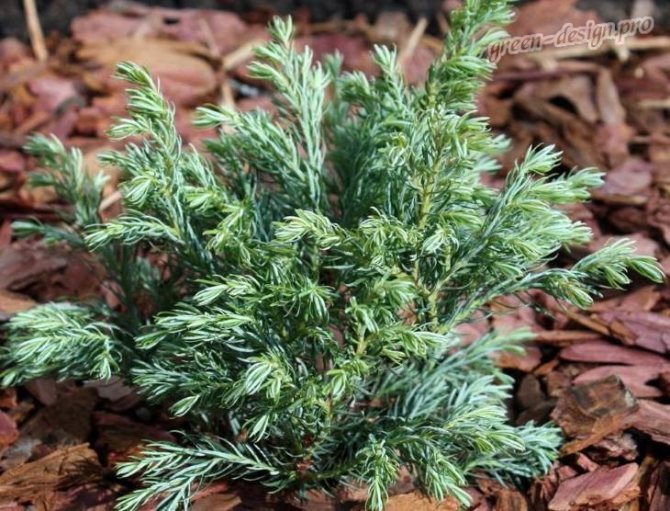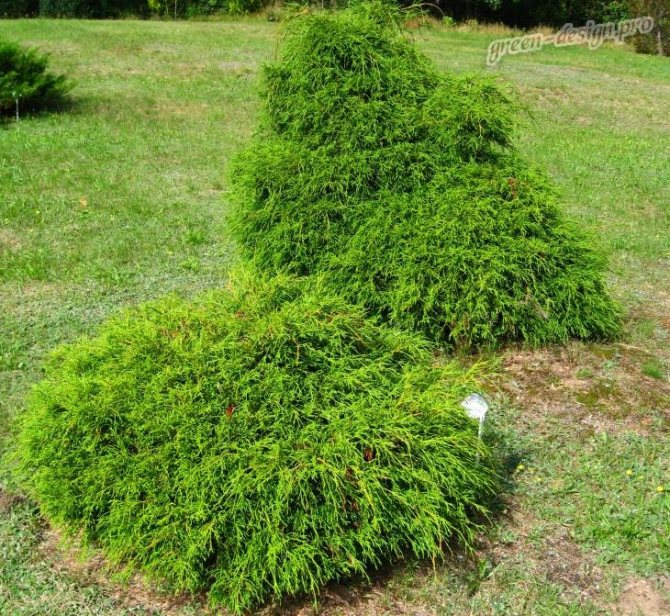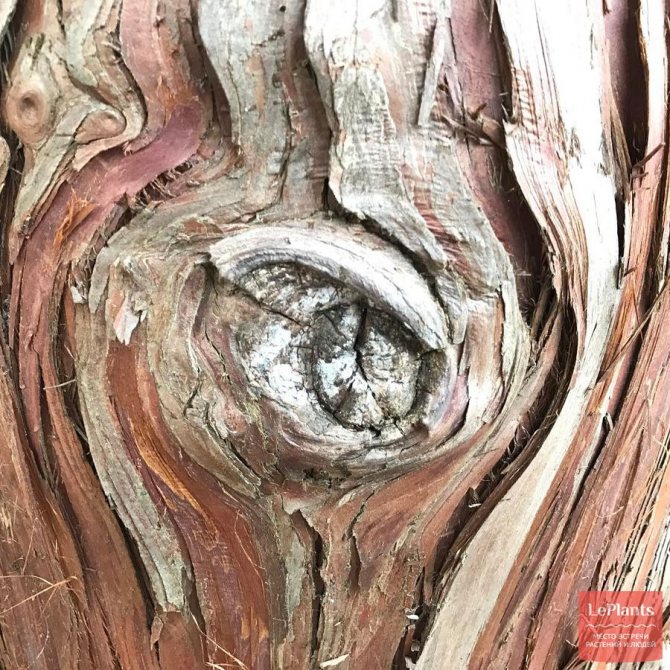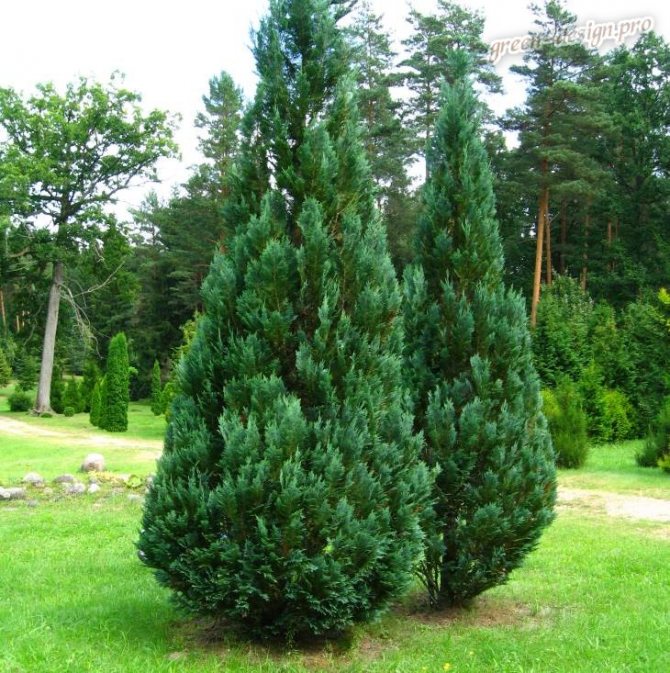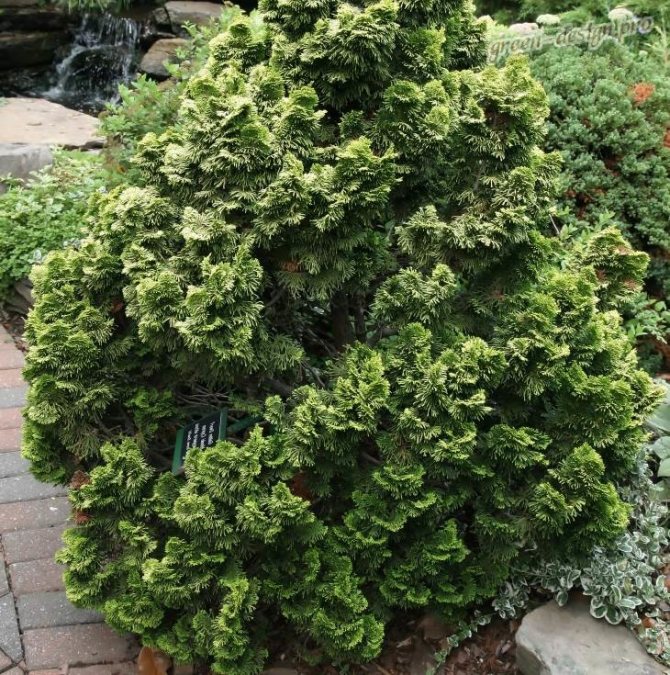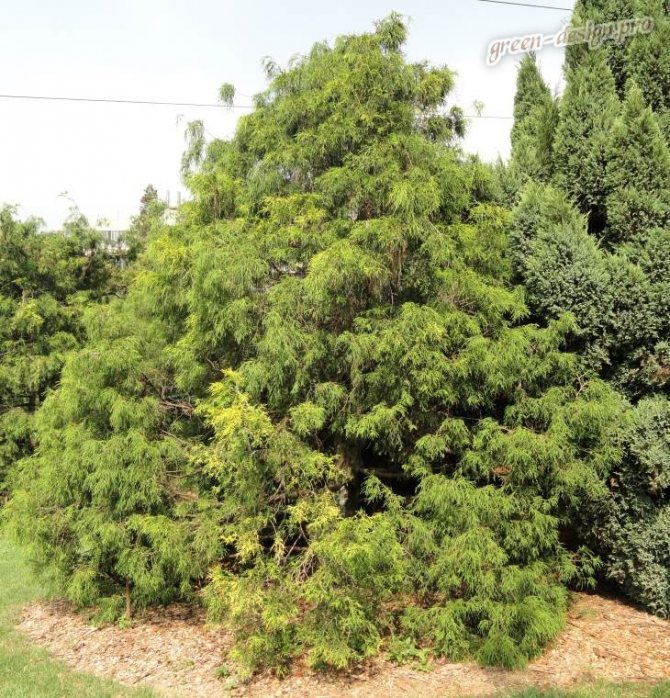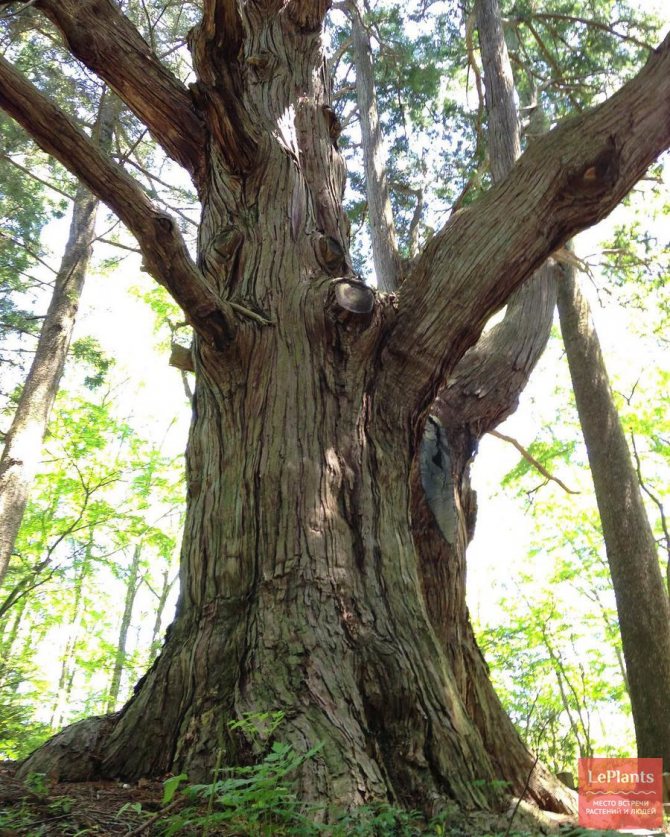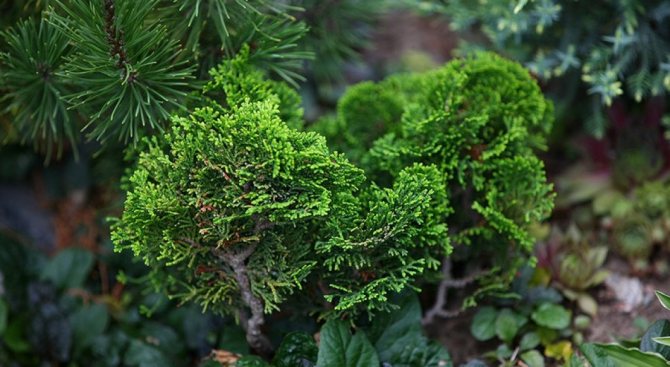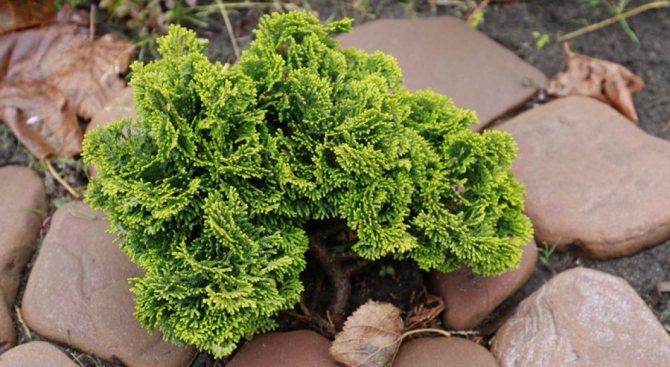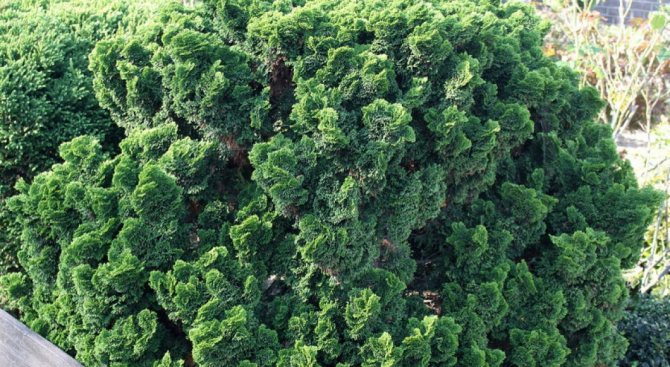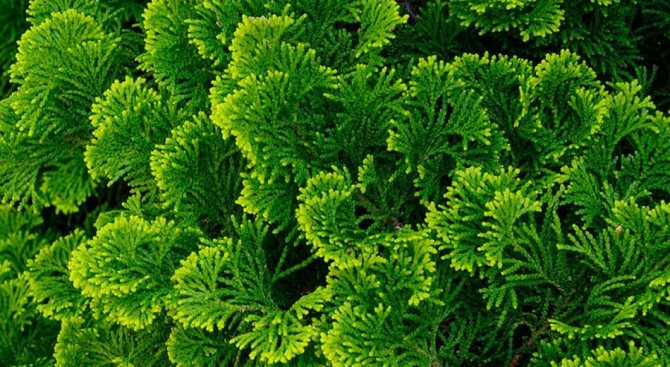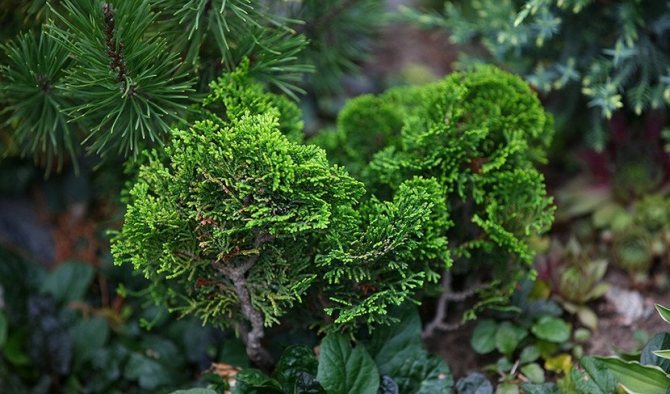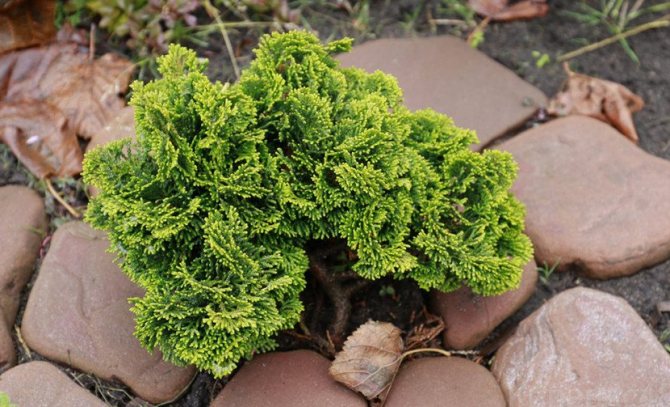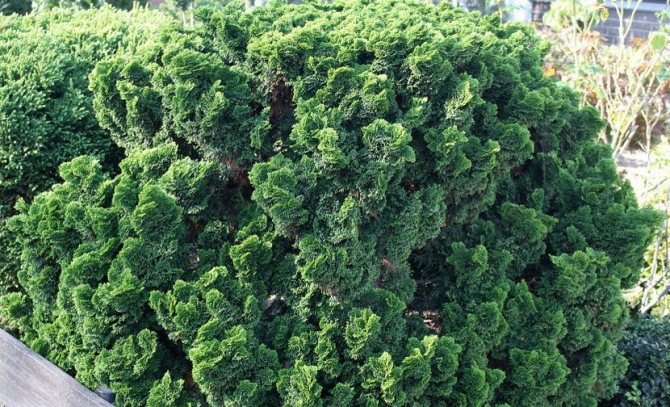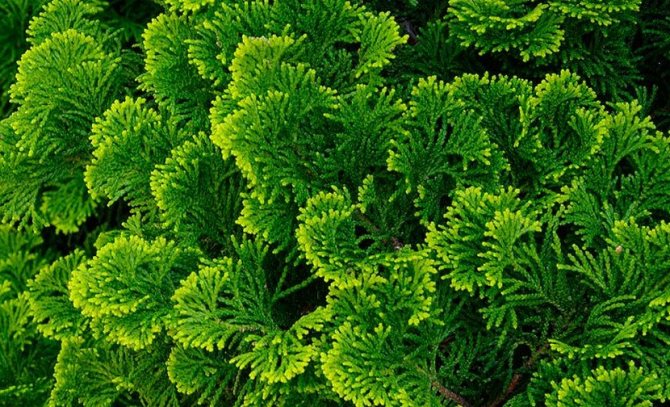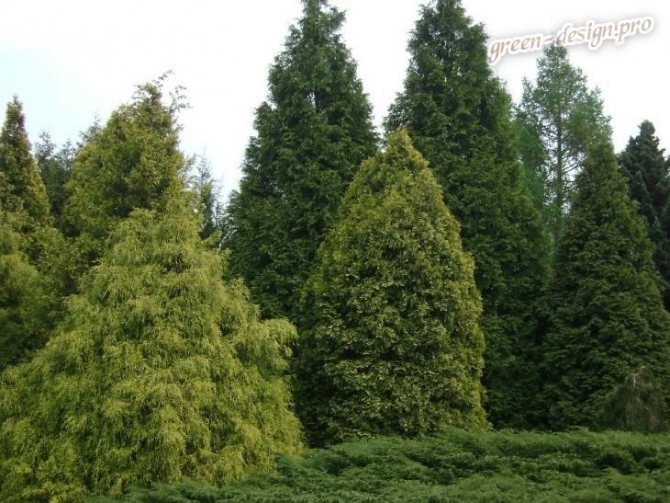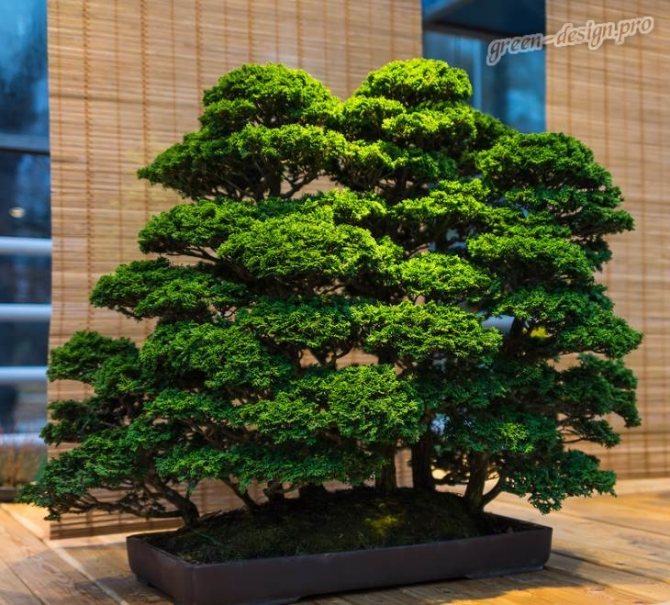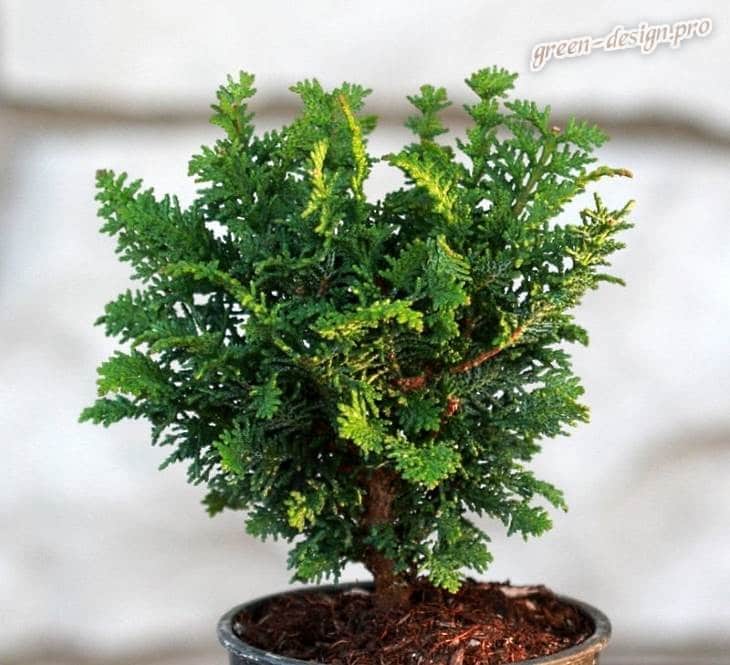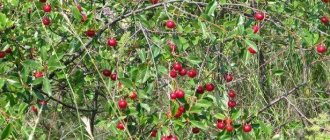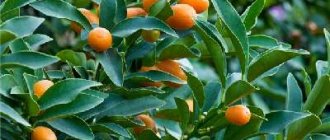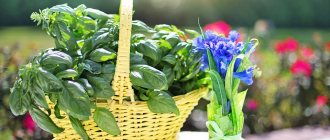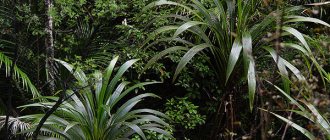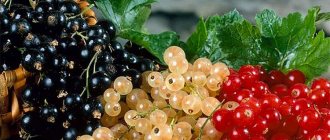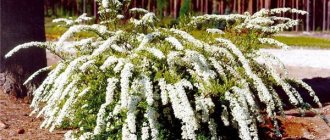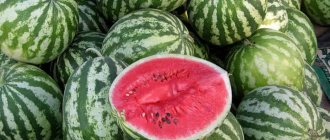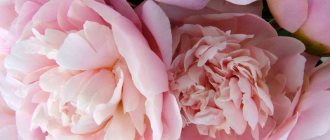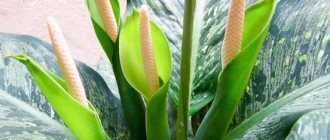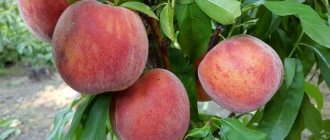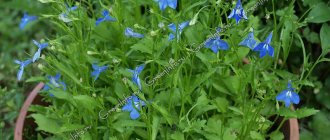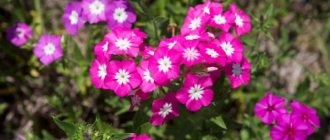Presented by trees and shrubs. They belong to conifers. They belong to the extensive Cypress family. They are often confused with cypress. Mainly due to the consonance of the names and some external similarity. The homeland of the cypress is considered to be the Asian countries - Taiwan and Japan, as well as the forests of North America. It was from there that they began their rapid conquest of the world's gardens. The cypress was introduced to Europe from the beginning of the 18th century, where it was widely used in decorating palace parks. In addition, some species are characterized by very high quality wood. In Japan, it is still used in the construction of Buddhist temples.
In our gardens, out of 7 existing species of cypress, only 5 are cultivated. These are dull-leaved (dull), pea-fruited, Lawson, nutkan and thue-like. Mourning and Formosan cypress trees are practically not grown. These 5 species are distinguished by good winter hardiness in adulthood, resistance to sunlight and the ability to grow on different types of soil. But almost all of them prefer moist soil. In addition, some species have pleasant-smelling needles.
Cypress is a great find for breeders and landscape designers. Due to the strong susceptibility to mutations, new forms often appear. On the basis of just a few species of cypress, more than 200 varieties have been bred to date. Cypress varieties differ from each other in all kinds of crown shapes (columnar, pyramidal, curved, weeping), speed, strength and direction of growth. Well, and of course, a wide range of colors of needles - from light bluish to golden yellow shades. Moreover, the cypress, like many other conifers, remains exclusively decorative throughout the season.
Pea cypress (lat. Chamaecyparis pisifera)
These are trees with good vigor. Basically, 25-30 m in height, but can reach 50 m. In cultivated form, the growth is much less, up to 10 m. The crown is narrow-headed or cone-shaped, with numerous branches spread horizontally. The twigs are drooping, densely covered with flat needles (leaves). In nature, it grows in the humid forests of the Japanese islands.
The needles themselves are flattened, loose, with pointed tops, an average length of 1.5 mm. The needles are adjoining, dark green in color, with an intense glossy shine, and whitish underneath. They have a weak coniferous aroma. Female cones are numerous, brown in color. They resemble small peas, up to 1 mm in diameter, attached to short petioles.
The bark of the tree is reddish blue or reddish brown, smooth. This type is characterized by very high quality wood. In winter, branches can break off under the weight of the snow. Interestingly, different cypress varieties in this group can have significant differences between themselves.
Many varieties of pea cypress trees are widely used in landscape design. Look great in compositions from plants of various colors. And of course they look spectacular in single landings. The best results are shown on fertile, breathable and moist soils.
Cypress "Boulevard"
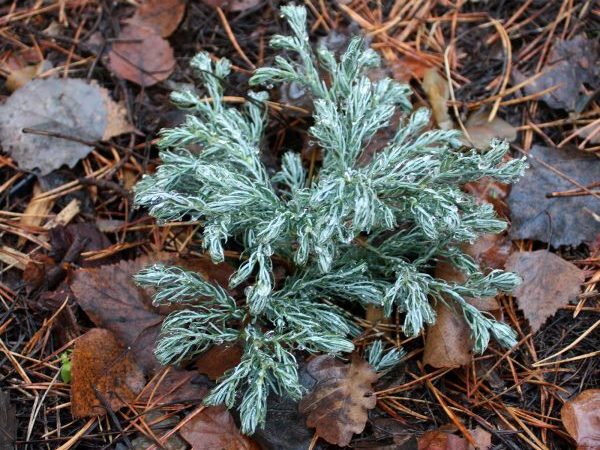
One of the most famous and widespread varieties. It is characterized as one of the bluest plants of its kind.The crown is conical in shape, with beautiful, lush and delicate needles and a reddish bark. When it hits the needles of direct sunlight, it shines enchantingly with silver. An adult plant, of this cypress variety, grows up to 1.5-2 m, less often up to 5 m and grows up to 1 m wide. At a young age, they grow rather slowly.
Young plants after wintering must be protected from the spring sun to avoid burns. For example, you can wrap the crown with agrofiber. The variety is quite winter hardy. It looks very decorative both in the joint planting of heather or conifers, and performing a solo role. It is worth paying attention - all parts of this cypress variety are poisonous!
Cypress "Plumosa (lat. Plumosa)"
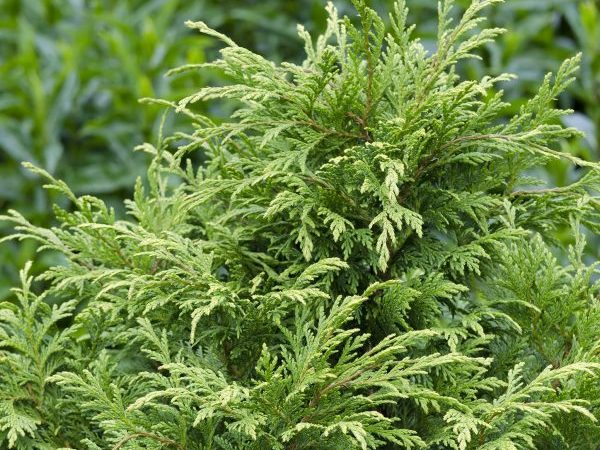

An unpretentious cypress variety. Reaches 10 m in height and half as small, up to 5 m in width. Numerous twigs are beautifully twisted. The needles are tetrahedral, soft, from 3 mm long, pleasant, rich green color. At the end of autumn, the color of the needles changes to brown. Growth up to 20 cm per season. Requires well-drained, fertile, moist soils without lime content. Can be grown in shade and partial shade. Differs in good winter hardiness.
Cypress "Plumosa Aurea (lat. Plumosa Aurea)"
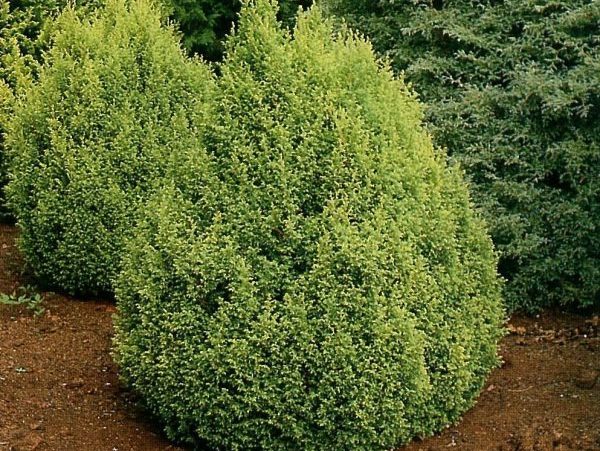

Plant with a conical, dense, fairly wide crown. It is characterized by needle-like, pointed, with a golden shade of needles. It grows up to 20 cm per year. This popular variety of Plumosa, closer to winter, acquires a spectacular, yellow-golden color of needles. They become a bright decoration of the autumn-winter garden. Differs in undemanding soil, light-loving and frost resistance.
Cypress "Filifera Nana (lat. Filifera Nana)"
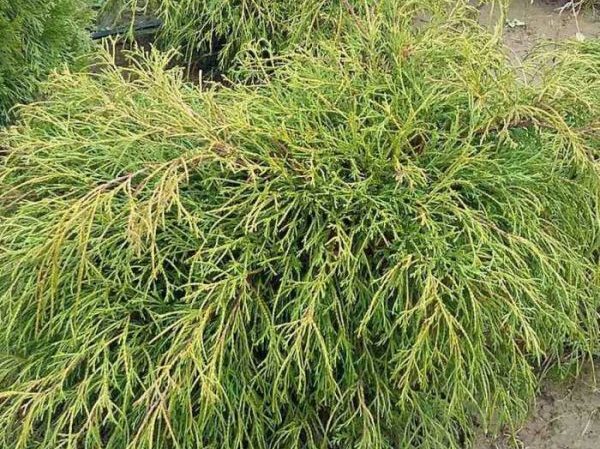

Very decorative, interesting dwarf cypress cultivar, bred in Germany. It grows rather slowly, for a year the growth is up to 3 cm. The branches of the bush are densely located, forming a pillow-like crown. Shoots are curved, hanging, threadlike, bright green. The bark is reddish brown. Prefers placement in the sun, but can grow in partial shade.
Using
An evergreen noble plant is used to decorate paths and alleys in a park and a large garden. It is planted in groups or singly in the middle of the lawn, as a bright accent. Low-growing, weeping shrubs are suitable for decorating rockeries, rocky gardens or alpine hills.
In summer, plants are the perfect backdrop for vibrant flowers, and in winter they can help turn a boring garden into a more conspicuous one. Moreover, some varieties change color to blue or golden in the cold season.
Post Views: 1
Cypress "Lawson (lat. Cupressus lawsoniana)"
Another common variant of the name is Lawson. It is a powerful, coniferous tree up to 80 m high. The species has a narrow conical crown. Has a great similarity to thuja. Homeland are the forests of Asia and the coast of North America. In cultivated form, its size is much more modest. He came to Europe in 1854 and quickly gained popularity among gardeners.
The bark is pronounced scaly, dark brown. Branches are horizontal or drooping, densely covered with scaly needles. The lower part of the trunk, under inappropriate growing conditions, can become bare due to drying out of the branches.
A big plus of this species is its high immunity to diseases and pests. It is able to develop well on different types of soils, from slightly alkaline to acidic. But he prefers well-drained, light and moist soils. It can grow both in the sun and in partial shade. But in the shade, varieties with brightly colored needles can acquire a green color. The species is moderately frost-resistant.
Cypress "Yvonne / Yvonne (lat. Ivonne)"
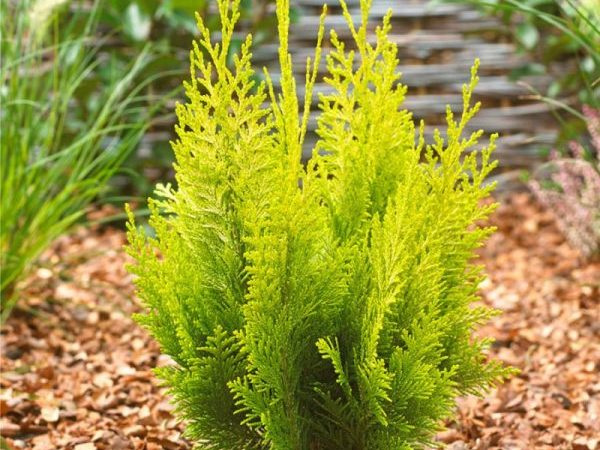

It is considered one of the best forms with yellow needles. The branches are effectively, fan-shaped, branched, forming a triangular crown. Differs in rapid growth, as for decorative cypress trees.By the age of 10, it grows up to 2.5 m in height and 2-3 m in width.
The needles are flattened, scaly, golden yellow, and often saturated yellow. Moreover, the intensity of the color directly depends on the humidity of the air and the fertility of the soil. The color in the winter period remains the same bright and spectacular, but when grown in the shade it becomes light green. Does not tolerate sodding of the soil surface.
Ellwoodii cypress


Named after an English gardener. The crown is wide, dense, conical in shape with vertical, tightly closed branches. The tops of the shoots are drooping. This variety grows slowly and unhurriedly. It grows only up to 1-1.5 m by 10 years of age. The needles are greenish-blue, dark, sometimes with a gray-blue tint. Prefers growing in the open sun, but also tolerates placement in partial shade.
Possesses great resistance to diseases and pests. This is a fairly common variety. Especially often it can be found on New Year's Eve. Almost all garden centers and supermarkets sell medium-sized Christmas trees in pots. And half of them are Elwoodi cypress trees.
Care rules
Street cypress trees love high soil and air humidity. They should be watered and sprayed regularly. In the absence of natural precipitation, a bucket of water is poured under the tree weekly. It is better to spray the plants in the evening. The soil in the root soil is regularly loosened to a depth of about 20 cm. Weeds may develop near the young tree and should be removed. It is useful to mulch the surface with peat or sawdust.
For active growth, the cypress needs top dressing. In April-June, 1-2 times a month, the soil is sprinkled with mineral complex fertilizer, and then the plant is watered abundantly. It is best to use half of the recommended dose. From July-August, feeding is stopped so that the cypress is prepared for wintering.
Most species are frost resistant, but can suffer in cold, snowless winters. In autumn, the near-stem circle is mulched with peat and covered with fallen leaves. Young cypress trees can be completely covered with spruce branches and non-woven material. In early spring, the entire shelter is removed, and the snow is scattered so that the plants do not mute.
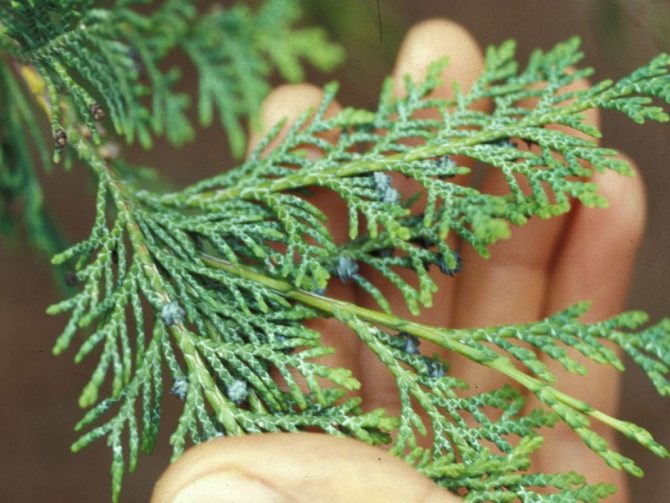

To shape, the cypress trees are sheared. They tolerate this procedure well, but it should be carried out in early spring. During pruning, frozen and dry branches are removed, and shoots that are knocked out of the general shape are cut off. The latter are shortened to a third of the length.
The cypress is a plant resistant to diseases and parasites. Only weakened specimens suffer from pests such as spider mites or scale insects. An insecticide treatment will quickly get rid of insects. With frequent flooding of the soil, root rot can develop. It is possible to escape from it only at an early stage. At the same time, the soil and plants are treated with a fungicide.
Blunt cypress (Cupressus obtusa)
Comes from the highlands of northern Japan. In nature, it grows at high humidity. These are tall, rather powerful trees, with a conical and dense crown. They can reach a height of 40 m. The branches are spaced, with shiny needles up to 2 cm. The cones are round, up to 1 cm in diameter. The bark is light brownish. Prefers fertile, regularly moistened soils. Many original cypress trees have been bred with various crown shapes, density and color of needles. And also dwarf varieties that are quite appreciated by designers.
Cypress "Nana Aurea (lat. Nana Aurea)"
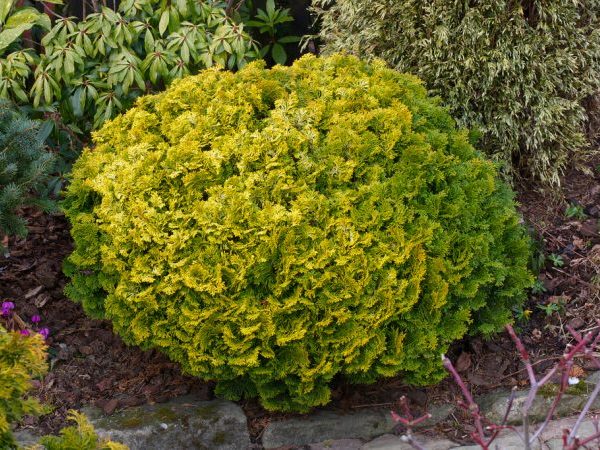

Slow growing, dwarf and therefore valuable. By the age of 10, it grows to 0.5-0.8 m, and the diameter barely reaches 0.5 m. The crown is of an interesting shell-like shape. Shoots are short, twisted, with golden yellow needles. The needles themselves are small, thin, tightly adjacent to each other. Prefers nutritious, regularly moistened soil. It is widely used in Japanese gardens and is an excellent plant for alpine slides, all kinds of stone gardens, rockeries.
Cypress "Nana Grasilis (lat. Nana Gracilis)"
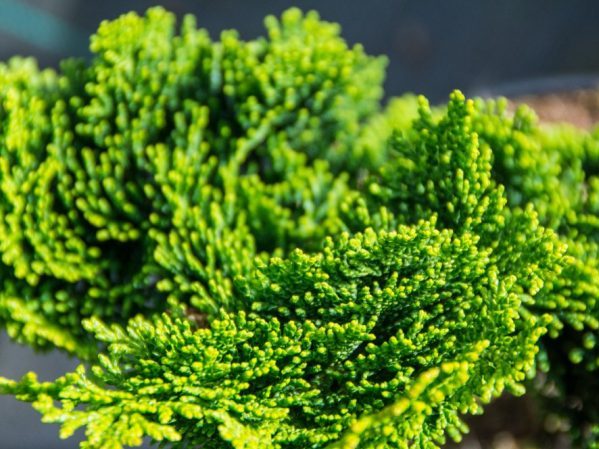

A variety with a rounded crown and needles of a juicy, rich green, sometimes dark color. The branches are quite densely arranged. They bizarrely bend, resembling twisted sea shells. This graceful dwarf variety develops slowly, growing only 5 cm up and 3 cm in width during the season. Prefers fertile, sour and moist soils. As well as cultivation in partial shade. The variety is quite popular in Europe, used for planting on alpine hills. Among other things, it is great for creating heather gardens in acidic soils.
Fernspray Gold cypress
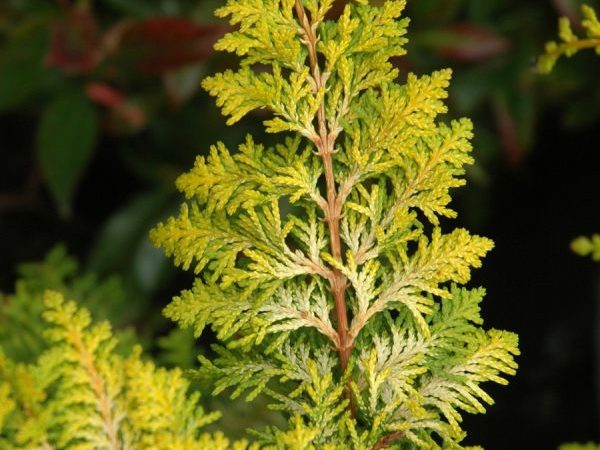

An original, elegant, low tree with a bright, beautiful color of the needles. The maximum height in adulthood is 2.5-3 m, and the diameter is up to 1 m. The growth during the season is 5-7 cm. The branches are slightly arcuate, unevenly spaced from the trunk and branching strongly at the ends. Young growth with an interesting lemon flavor. This variety is quite winter hardy. Does not tolerate drying out of the soil.
Preparation of the root system - roslin in containers
Roslin is protected from the container so that it will not be shipped from the container.
Successful planting and further into the root of the growing line to the great world to lie down as a result.
Roots grow deeper than ever, easy to break and tear. Do not growlini vityagati with force from the container for the above-ground part. Large containers can be carefully crafted, small containers can be turned over, lightly knocked, so that the growling will be easier in the morning. As the roots of the twist and fix the ball in the corner, the part needs to be seen with a pruner, and then, you need to carefully distribute it. Tse lodge the root penetration into the ground. To drink, well, the roslin in the container is overdried, so it is necessary before landing on the decilka of khviliin, "soak up" the lump near the water, abi vin is good. The overdrying of the planting plant is rotten to nourish the irrigation.
Nutkan cypress (lat. Cupressus nootkatensis)
Coniferous, evergreen tree, notable for its measured growth. Belongs to the extensive Cypress family. It grows on the entire Pacific coast of the United States, from California to Alaska. It grows up to 30-40 m, it has a narrow-gelatinous crown, branches are dense, spreading, hanging. The bark of the plant is brownish gray. The needles are deep green in color, sometimes darkish. Gives off a strong, unpleasant odor when damaged. Cones are round, up to 1 cm in volume, red-brown. It was brought to Europe from the USA in 1850. The species is quite frost-resistant. It develops well at high humidity. Prefers regular spraying in crop production.
Cypress "Pendula (lat. Pendula)"
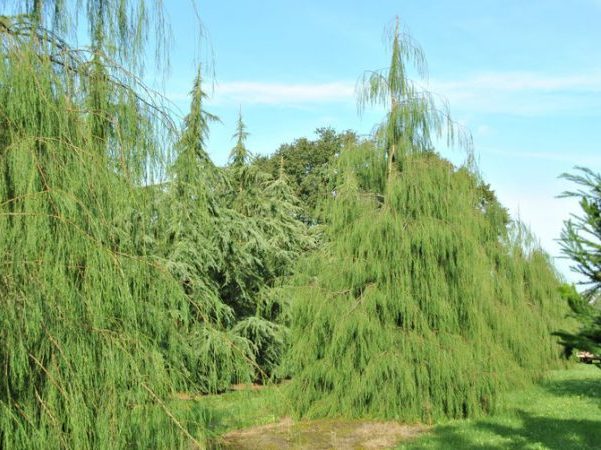

A charming weeping cypress tree. One of the best in its kind. Differs in a dense, graceful conical crown. They are characterized by fan-shaped, drooping branches and a sloping top. The needles consist of small, deep green scales with a glossy sheen.
It grows up to 10-15 m maximum, and the diameter of the entire crown reaches 3.5-5.5 m. It has good frost resistance and is not demanding on the soil. It is characterized by moderate growth at a young age.
Cypress "Glauca (lat. Glauca)"
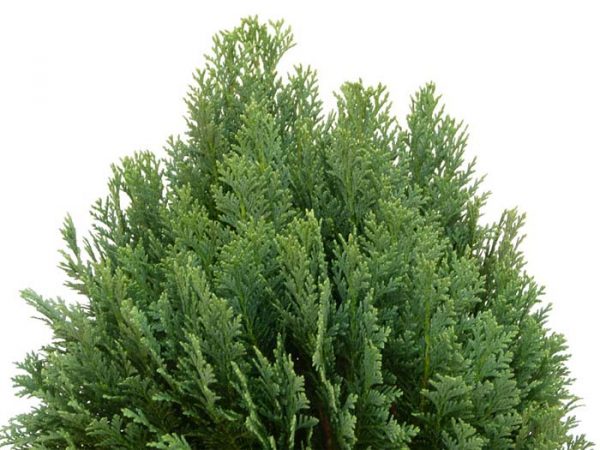

An energetic, fast-growing variety with a symmetrical cone-shaped crown. During the year, the growth is about 25-30 cm in height and up to 15 cm in width. The branches are powerful, densely covered with needles, spreading and slightly hanging. The needles are long, juicy green-bluish shade. Shade-tolerant and frost-resistant variety. It is actively used for planting in parks. In landscape design it is used as a "solo" plant.
Breeding methods
This variety of Chamaecyparis Nana Gracilis can be grown by cuttings or by seed.
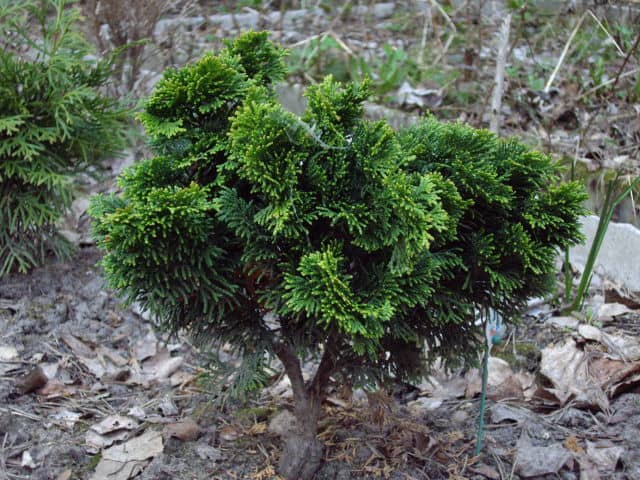

Cuttings
This option is different:
- simplicity;
- reliable result.
The result is a lot of good trees with all varietal characteristics.
Cuttings are obtained in the spring, in which case the seedlings have time to take root before the onset of cold weather. First, on an adult plant, strong, healthy shoots are selected, from which cuttings 10-15 cm long are cut so that they have a "heel". This will then allow the seedlings to take root faster.
Needles are removed from the lower part of the cuttings and planted in pots pre-filled with moistened soil. The containers are covered with foil.
Cuttings take root for 2 months, while they are regularly ventilated and watered. Then the cuttings are planted in a separate prepared bed, and each seedling is covered with a plastic bottle.
With proper care, they take root quickly enough, so they are sheltered for the winter, not being transferred to a closed room. After a couple of years, during which the cuttings are left to grow, they are planted in a permanent place.
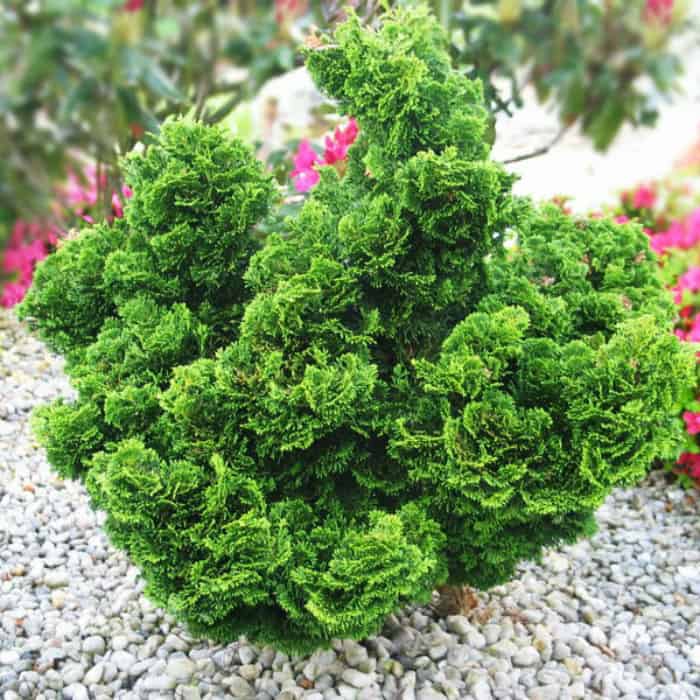

Seed propagation
This method is used abruptly, since some of the varietal characteristics of the plant are not preserved. As a result, you can get a tree, the appearance of which can be completely unexpected.
To grow Cypress with seeds, you first need to collect them, waiting for the cones to ripen. You need to be in time until the moment when their scales open and the seeds scatter. By the way, you can harvest them for future use, because they are distinguished by good germination.
After harvesting, the seeds are dried in a warm room with good ventilation. Then they are used in one of the following ways:
- sowing in the fall into open soil;
- sowing after stratification into containers.
For stratification, the seeds are placed in light soil, placed in a refrigerator. You can use a container, it is dripped with snow. After 2 months, the boxes are placed in the house, here the seeds are thawed, sprouted at a temperature of +3 degrees.
After the sprouts appear, the containers are transferred to a bright room, sheltered from direct sunlight.
Seedlings need competent care, which is as follows:
- regular watering;
- weed removal.
When the seedlings get stronger, foliage appears, they are dived into separate containers or immediately into the open ground on a special bed. There Cypress is grown for 5-6 years, after which it is transplanted to a permanent place.
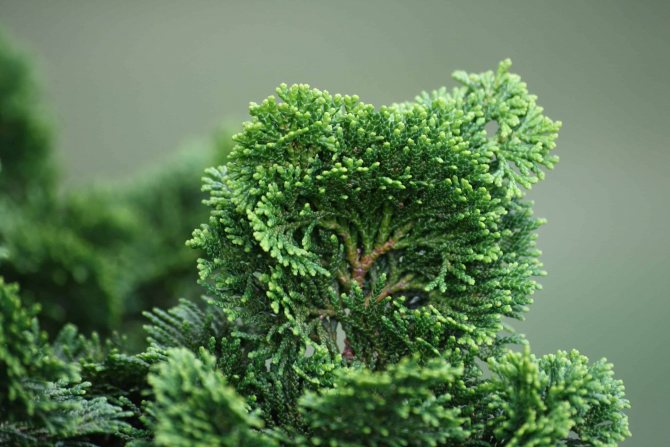

Thuate cypress (lat. Cupressus thyoides)
Originally only found in North America. And from there it has already begun to spread. This is an evergreen tree with a narrow cone-shaped crown. Height up to 25 m high and 10 m wide. Dark green or light bluish needles with a slight coating. Cypress bark is brownish with a red tint. When rubbed, the needles emit a characteristic pungent odor.
Red Star cypress
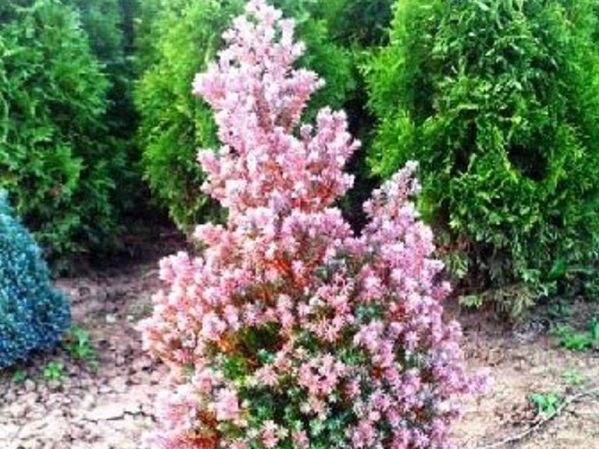

A very decorative variety with a pyramidal crown, less often aligned, columnar shape. It grows up to 2 m in height and up to 1.5 m in width. Changes the color of the needles throughout the year. Closer to winter, with a rich, greenish-blue, it becomes burgundy. Prefers placement in the sun, but tolerates partial shade. A frost-resistant variety that prefers moist, light soils. Growing in a volumetric container is possible.
Preparing the landing time
A pit for planting a ma buty of a suitable size.
Call the pit to shake off the bigger one, below the lump of the growing line.
The top ball is good for the soil, the bottom is less, it is less of all microelements, like for example, sand is clay.
In the fallow state, there is a green soil with compost and combustible garden soil.
Well the soil is single and permeable, the sum is, it’s added, it’s rich in humus and it’s tied up, and it’s too tight for the water and the lively speech. If navpaki, the soil is heavy and will be done to the doctor, then it is necessary to lay down the sack. At the bottom of the growth of an impenetrable clayey abnormal, the bottom of the planting yields followed by good expansion and loss of gravity. This allows you to let the water in the landings be introduced in a small part, or to transform yourself into a housekeeper without drainage openings. Yakshcho soil is even more schilny, it will not be pushed as well as planting stakes.For heather dews, the soil is mat and acidity (sour).

